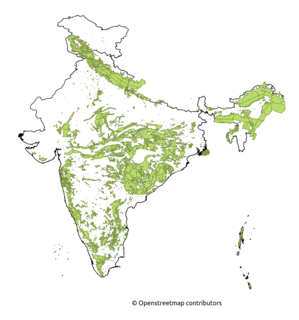
Terminalia is a genus of large trees of the flowering plant family Combretaceae, comprising nearly 300 species distributed in tropical regions of the world. The genus name derives from the Latin word terminus, referring to the fact that the leaves appear at the very tips of the shoots.

Anogeissus is a genus of trees in the family Combretaceae. The 10 to 12 species are distributed in Asia and tropical Africa. Plants of the World Online now refers to this genus as a synonym of TerminaliaL.
Podocarpus purdieanus is a species of conifer in the family Podocarpaceae. It is endemic to Jamaica. Its common name is yacca, or St. Ann yacca.
Baccaurea latifolia is a species of plant in the family Phyllanthaceae. It is found in Malaysia and Singapore.
Helicia latifolia is a species of plant in the family Proteaceae. It is endemic to Papua New Guinea. It is threatened by habitat loss.
Palicourea latifolia is a species of plant in the family Rubiaceae. It is endemic to Peru.

Terminalia acuminata is a tree species in the Combretaceae family. It was endemic to the Atlantic Forest in Brazil. The species was believed to be extinct in the wild from habitat loss, entering the IUCN Red List in 1998, with two individuals remaining in the Rio de Janeiro Botanical Garden.
Terminalia arbuscula, also called white olive, is a species of plant in the Combretaceae family. It is endemic to Jamaica. It is threatened by habitat loss.

Terminalia cherrieri is a species of plant in the Combretaceae family. It is endemic to New Caledonia. It is threatened by habitat loss. The dry forest habitat of Terminalia cherrieri has been reduced by roughly 95% over the past 150 years, largely for agricultural use.

Terminalia eriostachya, the black mastic, is a species of flowering tree in the leadwood family, Combretaceae. It is endemic to Cuba and the Cayman Islands. It is threatened by habitat loss.
Terminalia ivorensis is a species of tree in the family Combretaceae, and is known by the common names of Ivory Coast almond, idigbo, black afara, framire and emeri.
Terminalia januariensis is a species of plant in the Combretaceae family. It is endemic to the Atlantic Forest ecoregion, in Minas Gerais and Rio de Janeiro states of southeastern Brazil. It is threatened by habitat loss.
Terminalia kangeanensis is a species of plant in the Combretaceae family. It is a tree endemic to Java in Indonesia.

Terminalia nitens is a species of plant in the Combretaceae family. It is found in Japan and the Philippines. It is threatened by habitat loss.
Terminalia novocaledonica is a species of plant in the Combretaceae family. It is endemic to New Caledonia.
Terminalia parviflora is a species of plant in the Combretaceae family. It is endemic to Sri Lanka.
Terminalia pellucida is a species of plant in the Combretaceae family. It is endemic to the Philippines. It is threatened by habitat loss.
Terminalia reitzii is a species of plant in the Combretaceae family. It is endemic to Brazil. It is threatened by habitat loss.
Terminalia rerei is a species of plant in the Combretaceae family. It is endemic to the Solomon Islands. It is threatened by habitat loss.

Tropical evergreen forests of India are found in the Andaman and Nicobar Islands, as Western Ghats, which fringe the Arabian Sea, the coastline of peninsular India, and the greater Assam region in the north-east. Small remnants of evergreen forest are found in Odisha state. Semi-evergreen forest is more extensive than the evergreen formation partly because evergreen forests tend to degrade to semi-evergreen with human interference. There are substantial differences between the three major evergreen forest regions.







